Ann Lethbridge's Blog, page 31
March 14, 2011
Royal Wedding Celebration
 As the world gears up to celebrate the marriage of William and Kate, Harlequin is having its own celebration. Six Harlequin Historical authors have written digital short stories about the Royal Weddings of the past. Check them out today at http://harlequinblog.com/ Do leave a comment.
As the world gears up to celebrate the marriage of William and Kate, Harlequin is having its own celebration. Six Harlequin Historical authors have written digital short stories about the Royal Weddings of the past. Check them out today at http://harlequinblog.com/ Do leave a comment.Needless to say yours truly has written one of those stories and watch this space for more information about the upcoming contest we plan to hold on April 1st for the launch of this series.
Until next time, Happy Rambles
Published on March 14, 2011 06:30
March 10, 2011
Searching for Regency London
Where did the week go!
My walk along the Thames is almost at an end, but there were a few stray pictures that I took that I thought would be nice to finish up with.
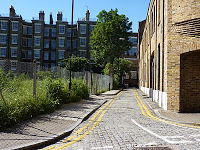
This is what would have been a typical width of an alley in this dockside area. I was fascinated by the double yellow lines which mean no parking. Duh! Do you see the other lines on the cobbled road, the white ones? They mean this is a two way street. I imagine there is a fair amount of sidewalk (called a path or a pavement in England) passing, or backing up.
Of course, I need to think about my hero or heroine leaving their vehicle out in the street in such circumstances, held of course by the handy snotty-nosed urchin who always happens to be standing by. He is so not leaving a curricle there.
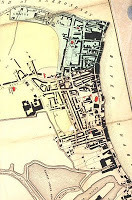
 This is the Angel, in Rotherhithe, a parish within the Borough of Southwark. A pub has stood on this spot since the seventeeth century and was in our time surrounded by tobacco warehouses.
This is the Angel, in Rotherhithe, a parish within the Borough of Southwark. A pub has stood on this spot since the seventeeth century and was in our time surrounded by tobacco warehouses.
The map shows this area in 1848.
Back on the Wapping side of the stream (just joking)
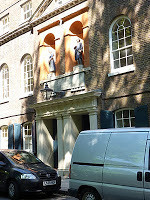
This is a school. St John of Wapping, a charity school founded in 1695 and this building erected by subscription in 1760. The statues show a boy and a girl and they stand over the separate entrances for each gender.
Not a great picture because the the parked vehicles. Where are the double yellow lines when you need them?
My final picture in this series is one of the warehouses still standing along the wapping side of the docks.
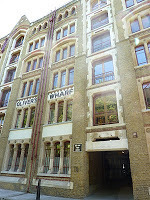 Built for the import of tea in 1869, it is well outside of our era, but not so far that it is not worthy of inclusion.
Built for the import of tea in 1869, it is well outside of our era, but not so far that it is not worthy of inclusion.
Well that's it. Lots more places to go and lots more to see, and a new book cover on the horizon for next time.
Until then, Happy Rambles.

My walk along the Thames is almost at an end, but there were a few stray pictures that I took that I thought would be nice to finish up with.

This is what would have been a typical width of an alley in this dockside area. I was fascinated by the double yellow lines which mean no parking. Duh! Do you see the other lines on the cobbled road, the white ones? They mean this is a two way street. I imagine there is a fair amount of sidewalk (called a path or a pavement in England) passing, or backing up.
Of course, I need to think about my hero or heroine leaving their vehicle out in the street in such circumstances, held of course by the handy snotty-nosed urchin who always happens to be standing by. He is so not leaving a curricle there.

 This is the Angel, in Rotherhithe, a parish within the Borough of Southwark. A pub has stood on this spot since the seventeeth century and was in our time surrounded by tobacco warehouses.
This is the Angel, in Rotherhithe, a parish within the Borough of Southwark. A pub has stood on this spot since the seventeeth century and was in our time surrounded by tobacco warehouses.The map shows this area in 1848.
Back on the Wapping side of the stream (just joking)

This is a school. St John of Wapping, a charity school founded in 1695 and this building erected by subscription in 1760. The statues show a boy and a girl and they stand over the separate entrances for each gender.
Not a great picture because the the parked vehicles. Where are the double yellow lines when you need them?
My final picture in this series is one of the warehouses still standing along the wapping side of the docks.
 Built for the import of tea in 1869, it is well outside of our era, but not so far that it is not worthy of inclusion.
Built for the import of tea in 1869, it is well outside of our era, but not so far that it is not worthy of inclusion. Well that's it. Lots more places to go and lots more to see, and a new book cover on the horizon for next time.
Until then, Happy Rambles.
Published on March 10, 2011 07:32
March 3, 2011
Regency Timelines
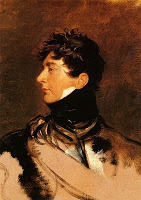 What did happen during the Regency? Apart from the fact that a regent ruled England that is. Give the 200th anniversary of our beloved period, I thought it might be interesting to tract some of the interesting historical events during this period in date order.
What did happen during the Regency? Apart from the fact that a regent ruled England that is. Give the 200th anniversary of our beloved period, I thought it might be interesting to tract some of the interesting historical events during this period in date order.So we will start with the year 1811, the Regency having begun in February that year. George, the Prince Regent, was now heading for forty-nine and was no longer Prince Charming. Wellesley, who was eventually to become the Duke of Wellington, had been fighting the French on the Iberian Peninsular (Portugal and Spain) since May of 1809.
January 1811 saw a very cold winter.
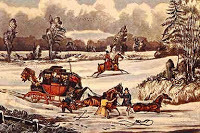 Jan. 4: A heavy fall of snow rendered the northern roads almost
Jan. 4: A heavy fall of snow rendered the northern roads almost impassable. The river Severn froze. The River Thames frozeJan. 5: Two outside passengers on the Carlisle coach frozen to death.Jan. 10. A monster, or women hater, dangerously wounded a female in St. James's ParkJan. 13: Gallant Action in which the merchant ship Cumberland, Capt. Barratt, beat off four French privateers.Jan. 16: A chimney sweep's boy suffocated in a chimney in Orchard street, Westminister.Jan. 22: The Cosgrove Aqueduct, an iron aqueduct bridge of the Grand Junction Canal over the
 river Ouse near Stratford (pictured here), opened for the passage of boats. This is a cast iron trough in which canal boats navigated from one side of the river to the other passing through several locks as it moves up hill. A tow path runs alongside the canal on one side, on the other it looks something like an infinity pool. Jan. 31: there was an eruption of a volcano in 80 fathoms of water, near Azores.Feb.6: His R.H. the Prince of Wales was sworn into office of Regent.Feb.10: A conflagration near Limehouse hole stairs (on the river near the southwest India dock) destroyed four warehouses and twelve dwelling houses.Feb.23: A decree of Bonaparte ordered prisoners of war to be employed as laborers. Feb.26: John Liles sentenced to seven years transportation, for bigamy.Feb.26: Hadje Hassan, ambassador from Algiers, had his first audience of the Prince Regent.Feb.27: The House of representatives in the American congress passed a bill prohibiting intercourse with Great Britain and on Feb. 28 Mr. Pinkney, the American minister in this country, had his audience of leave.So passes the beginning of the Regency. Until next time, Happy Rambles
river Ouse near Stratford (pictured here), opened for the passage of boats. This is a cast iron trough in which canal boats navigated from one side of the river to the other passing through several locks as it moves up hill. A tow path runs alongside the canal on one side, on the other it looks something like an infinity pool. Jan. 31: there was an eruption of a volcano in 80 fathoms of water, near Azores.Feb.6: His R.H. the Prince of Wales was sworn into office of Regent.Feb.10: A conflagration near Limehouse hole stairs (on the river near the southwest India dock) destroyed four warehouses and twelve dwelling houses.Feb.23: A decree of Bonaparte ordered prisoners of war to be employed as laborers. Feb.26: John Liles sentenced to seven years transportation, for bigamy.Feb.26: Hadje Hassan, ambassador from Algiers, had his first audience of the Prince Regent.Feb.27: The House of representatives in the American congress passed a bill prohibiting intercourse with Great Britain and on Feb. 28 Mr. Pinkney, the American minister in this country, had his audience of leave.So passes the beginning of the Regency. Until next time, Happy Rambles
Published on March 03, 2011 20:42
February 28, 2011
Searching for Regency London
 The last day of February and I have to finish edits for a book due out in the Fall. If you like sneek peeks, how about this title. Lady Rosabella's Ruse.
The last day of February and I have to finish edits for a book due out in the Fall. If you like sneek peeks, how about this title. Lady Rosabella's Ruse. Oh and I have my UK cover for More than a Mistress
 . Here it is here. It will be out in North America in May.
. Here it is here. It will be out in North America in May.London
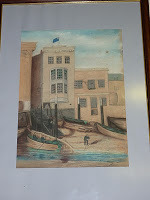 My next topic is something I have blogged about before. The Thames River Police I . Thames River Police II
My next topic is something I have blogged about before. The Thames River Police I . Thames River Police III have linked to the earlier posts so you can take a look at them as an introduction. This time, I was able to visit the museum and can fill in a few more details. I must say I liked the idea of standing in a building that parts of it dated back to the Regency. And it is nice to know that the Force continues to this day, albeit in a very different form.
The pictures I am adding today were taken in the museum with the kind permission of the museum's curator Robert Jeffries, who was a member of that illustrious Police force.
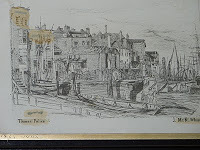
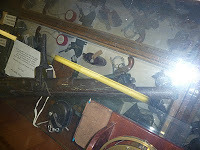 This picture is from 1859, but still it gives the feel of our time, the spars and masts, the wooden boats beached on the side of the river, the building unchanged from that above.
This picture is from 1859, but still it gives the feel of our time, the spars and masts, the wooden boats beached on the side of the river, the building unchanged from that above. The Museum contains many treasures and mementos from the work of the police, as you can see from this cabinet.
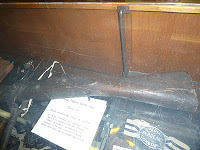
 Of particular interest is the police boat gun from 1798.
Of particular interest is the police boat gun from 1798. You can make out the stock behind the glass and the thole , a wooden pin or one of a pair, set upright in the gunwales of a rowing boat to serve as a fulcrum in rowing (rowlock), only in this case it was used to support this very large weapon. It was too large to be held and fired.
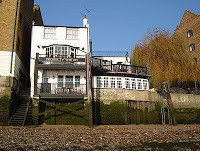
Publicans at inn like the Town of Ramsgate, pictured in detail last time, and the Prospect of Whitby, pictured here, were owned by what were known in those days as Master Lumpers. They organized the Lumpers, the men who unloaded the ships. they were also the men who stole a great deal of the contents of those ships, seeing it as a gratuity for the work they did. Everything from sugar to coal.
Some of the terminology for the Thames River Police and those working on the river at the time:
Watermen - constables
Surveyors - warrant or customs warrant.
Lighters - boats wich take the cargo off to unload it a the warehouses
Lumpers - the labourers who unloaded the cargo
Sweepings - the first mate on a sugar carrying ship had the rights to "sweepings" what was left on the deck after unloading, and he would sell these rights to anyone who wanted to do the work to sweep them up. Interesting to think about what might have been in the resulting bag of sugar. or not.
Spillage - anything spilled was seen as a perk for various individuals and somehow there was a lot of spillage.
Tipstaff - a badge of office, like a warrant card today, and sometime used to carry a warrant for arrest in the handle. Also a weapon, a forerunner of the truncheon.
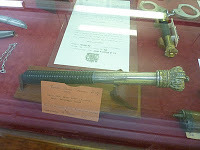
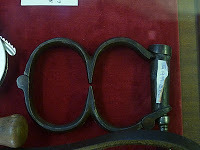 This is an inspectors tipstaff from 1827. And here are a couple of early handcuffs.
This is an inspectors tipstaff from 1827. And here are a couple of early handcuffs. Note the policeman's rattle in the second picture. The l-shaped large wooden object.
Note the policeman's rattle in the second picture. The l-shaped large wooden object.Rattles came into use sometime in the late seventeenth or early eighteenth century when night watchmen and/or village constables used them to "raise the alarm". They proved an ideal method to summon aid, sound the fire alarm, or, just generally get folks attention. A traditional rattle was constructed of wood, usually oak, where one or two blades are held in a frame and a ratchet turned - by swinging - to make the blades `snap' thus creating a very loud noise.
Of course we have only touched on the surface of the river and its police force but I do hope you have enjoyed the visit.
Until next time, Happy Rambles
Published on February 28, 2011 05:52
February 17, 2011
What I Did on my Holidays!
 Does the title remind you of those essays we had to write after the school summer holidays? I always hated them, because I never did anything, or at least not anything interesting. I used to make things up. I guess I'm still doing that. But this time I have pictures to prove I did do something
Does the title remind you of those essays we had to write after the school summer holidays? I always hated them, because I never did anything, or at least not anything interesting. I used to make things up. I guess I'm still doing that. But this time I have pictures to prove I did do somethingI thought it might make a change to share it on this blog, but be warned there is no regency or writing content.
We just got back from Costa Rica and I went zip lining. I loved it. I have to say that the helpful staff made it easy, but still, as a person who hates heights I had the feeling I might chicken out.
 But I didn't. I can't wait to go again. The weather in Costa Rica is gorgeous, unlike here today, where we have freezing rain.
But I didn't. I can't wait to go again. The weather in Costa Rica is gorgeous, unlike here today, where we have freezing rain.Here I am with the guys. This was the group that went around together. I was surprised at how safe it was, we were clipped on to a safety line at all times. Helmets were required, and then there were all the straps. And they provided water at intervals. It is very easy to dehydrate in the heat. So glad I wore that shirt; it shows up really well in the pictures, lol
Not once did I feel scared and as someone whose knees wobble every time I step one step up my kitchen ladder, that is saying something. Well, do I hear you say, it is all very well showing us a picture, but how do we know you actually did it? Aha, I cry. I have the video. This may take a bit of time to load on your computer, but if you have a minute, then give it a shot.
It's a bit jiggly, the guide taking it was on a platform at the top of a tree, and you can hear him shouting break at the end, telling me to pull down on the wire so I didn't slam into the tree. You can certainly see my big happy smile. Oh, I do want to have another turn.
So there we have it, what I did on my holidays. --There was lots more, we saw some of the countryside, and toured a national park, and of course went swimming in the ocean. The sand is black, or at least when it is on your feet it makes them look dirty, but the ocean was clear, and warm and we swam in it every day.
I haven't ever been anywhere more friendly or more interesting. So that's it for me, today.
Until next time, Happy Rambles.
Published on February 17, 2011 05:13
February 14, 2011
Happy Valentine's Day
Fall in Love Like a Romance Writer: Novelists Share Stories and Thoughts on Long and Lasting Love
 67 of us, including me, indeed. What more could you ask for today of all days?!
67 of us, including me, indeed. What more could you ask for today of all days?!
Hope your day is filled with love.

 67 of us, including me, indeed. What more could you ask for today of all days?!
67 of us, including me, indeed. What more could you ask for today of all days?!Hope your day is filled with love.
Published on February 14, 2011 13:44
February 10, 2011
Regency Fashion 1811
Fashion like a good way to mark the beginning of the Regency. The first article talks about fashion in general, then we have some descriptions of specific plates.
General Observations on Fashion and Dress, March 1811 from the February 1811 La Belle Assemblee
 The mourning for the late Princess Amelia expired on the 11th of last month, but though not general, the Court continued it in a slight degree for the deceased Queen of France. Sables are at length, however, entirely laid aside, and notwithstanding the season of Lent is not usually distinguished by much of variety, gloom seems to have subsided and gaiety and fashion fast entering on spring.
The mourning for the late Princess Amelia expired on the 11th of last month, but though not general, the Court continued it in a slight degree for the deceased Queen of France. Sables are at length, however, entirely laid aside, and notwithstanding the season of Lent is not usually distinguished by much of variety, gloom seems to have subsided and gaiety and fashion fast entering on spring.
For the promenade, scarlet mantles have been so general during the mourning, that for mere variety they must now be laid aside, we think they are more frequently succeeded by the short pelisse of purple velvet, trimmed with broad black lace, or small cottage mantlet, lined with white sarsnet, ornamented with white chenille or gold. Purple sarsnet pelisses, or black velvet, lined with colours, are equally approved.
Cottage bonnets, cloth turbans, or small velvet caps, and one long dropping ostrich feather, or two small ones, are more prevailing; under the cottage bonnets, which are formed to set off from the face, small lace caps, rosettes of lace or ribband, or small flowers are much worn, with a deep blue French veil thrown over. Purple, black, or scarlet boots, are universal for walking.
For morning dress, short pelisses of cambric corded muslin, over a slip of the same, trimmed with edging, or made in poplin, bombazeen, or lustres, with ruffs and cuffs of fine clear muslin, with bands of the same, and clasps of lope de perle.
Dinner dresses are most worn in lustres, sarsnets, Opera nets, or cloth, made up to the throat with lace cuffs, collars, and small French aprons of lace or fine embroidered muslin; and lace or quilted satin tippets, trimmed with swansdown, or white chenille.
The full dress, black or white lace over coloured or white satin slips, ornamented with gold, still continue the most admired, with pearl necklaces, combs, and other ornaments blended with emeralds.—Small tippets in antique lace or satin trimmed with swansdown, are considered indispensable, and small aprons of rich antique embroidered muslin with full pockets drawn and ornamented with white satin ribband, have an exceedingly elegant, and novel effect, and are much to be preferred to the ridicule so long in vogue.
For the Opera, blue or white satin, short pelisses, trimmed with dead silver or gold, with massy gold chains and bracelets, brooched with emeralds or amethysts, and crosses to correspond; and gold or silver bands or nets for the hair, which is dressed in full, large, round curls over the face, and divided on one side by a diamond, pearl, or ornamented comb.
Hair knots are just introduced, in embroidered lace, with gold or silver thread, forming a light rosette, to be disposed among the hair according to fancy.
Fashion for February 1811 from January 1811 La Belle Assemblee
 Walking Dress A pelisse of scarlet Merino cloth, buttoned down the front and up the arm with small gold buttons; the collar and cuffs of purple velvet; but during the mourning, of black, striped with scarlet; an empire tippet pointed in the back, and muffs of the same. A bonnet of scarlet cloth, turned up with velvet and formed to come over the face; the veil passed through the front, and brought round the neck. Boots of scarlet cloth trimmed with velvet.
Walking Dress A pelisse of scarlet Merino cloth, buttoned down the front and up the arm with small gold buttons; the collar and cuffs of purple velvet; but during the mourning, of black, striped with scarlet; an empire tippet pointed in the back, and muffs of the same. A bonnet of scarlet cloth, turned up with velvet and formed to come over the face; the veil passed through the front, and brought round the neck. Boots of scarlet cloth trimmed with velvet.
 Evening Full Dress. A round dress of white satin, sloped up in front; with small train ornamented round the bottom with velvet in a scroll pattern, vandyked at the edges, and dotted with black chenille; the velvet during the mourning should be grey or scarlet; the bosom, girdle, and sleeves of this dress are ornamented to correspond, in the form exhibited in the plate. A turban cap of white satin, looped with pearls, and edged with velvet; the hair combed full over the face, curled in thick flat curls, divided on the forehead. Necklace, earrings, and bracelets of gold and pearls blended. White kid shoes and gloves; fan of white crape and gold.
Evening Full Dress. A round dress of white satin, sloped up in front; with small train ornamented round the bottom with velvet in a scroll pattern, vandyked at the edges, and dotted with black chenille; the velvet during the mourning should be grey or scarlet; the bosom, girdle, and sleeves of this dress are ornamented to correspond, in the form exhibited in the plate. A turban cap of white satin, looped with pearls, and edged with velvet; the hair combed full over the face, curled in thick flat curls, divided on the forehead. Necklace, earrings, and bracelets of gold and pearls blended. White kid shoes and gloves; fan of white crape and gold.
These February 1811 gowns will be our bench mark for how the rest of the time period plays out in terms of fashion.
Until next time, Happy Rambles
General Observations on Fashion and Dress, March 1811 from the February 1811 La Belle Assemblee
 The mourning for the late Princess Amelia expired on the 11th of last month, but though not general, the Court continued it in a slight degree for the deceased Queen of France. Sables are at length, however, entirely laid aside, and notwithstanding the season of Lent is not usually distinguished by much of variety, gloom seems to have subsided and gaiety and fashion fast entering on spring.
The mourning for the late Princess Amelia expired on the 11th of last month, but though not general, the Court continued it in a slight degree for the deceased Queen of France. Sables are at length, however, entirely laid aside, and notwithstanding the season of Lent is not usually distinguished by much of variety, gloom seems to have subsided and gaiety and fashion fast entering on spring.For the promenade, scarlet mantles have been so general during the mourning, that for mere variety they must now be laid aside, we think they are more frequently succeeded by the short pelisse of purple velvet, trimmed with broad black lace, or small cottage mantlet, lined with white sarsnet, ornamented with white chenille or gold. Purple sarsnet pelisses, or black velvet, lined with colours, are equally approved.
Cottage bonnets, cloth turbans, or small velvet caps, and one long dropping ostrich feather, or two small ones, are more prevailing; under the cottage bonnets, which are formed to set off from the face, small lace caps, rosettes of lace or ribband, or small flowers are much worn, with a deep blue French veil thrown over. Purple, black, or scarlet boots, are universal for walking.
For morning dress, short pelisses of cambric corded muslin, over a slip of the same, trimmed with edging, or made in poplin, bombazeen, or lustres, with ruffs and cuffs of fine clear muslin, with bands of the same, and clasps of lope de perle.
Dinner dresses are most worn in lustres, sarsnets, Opera nets, or cloth, made up to the throat with lace cuffs, collars, and small French aprons of lace or fine embroidered muslin; and lace or quilted satin tippets, trimmed with swansdown, or white chenille.
The full dress, black or white lace over coloured or white satin slips, ornamented with gold, still continue the most admired, with pearl necklaces, combs, and other ornaments blended with emeralds.—Small tippets in antique lace or satin trimmed with swansdown, are considered indispensable, and small aprons of rich antique embroidered muslin with full pockets drawn and ornamented with white satin ribband, have an exceedingly elegant, and novel effect, and are much to be preferred to the ridicule so long in vogue.
For the Opera, blue or white satin, short pelisses, trimmed with dead silver or gold, with massy gold chains and bracelets, brooched with emeralds or amethysts, and crosses to correspond; and gold or silver bands or nets for the hair, which is dressed in full, large, round curls over the face, and divided on one side by a diamond, pearl, or ornamented comb.
Hair knots are just introduced, in embroidered lace, with gold or silver thread, forming a light rosette, to be disposed among the hair according to fancy.
Fashion for February 1811 from January 1811 La Belle Assemblee
 Walking Dress A pelisse of scarlet Merino cloth, buttoned down the front and up the arm with small gold buttons; the collar and cuffs of purple velvet; but during the mourning, of black, striped with scarlet; an empire tippet pointed in the back, and muffs of the same. A bonnet of scarlet cloth, turned up with velvet and formed to come over the face; the veil passed through the front, and brought round the neck. Boots of scarlet cloth trimmed with velvet.
Walking Dress A pelisse of scarlet Merino cloth, buttoned down the front and up the arm with small gold buttons; the collar and cuffs of purple velvet; but during the mourning, of black, striped with scarlet; an empire tippet pointed in the back, and muffs of the same. A bonnet of scarlet cloth, turned up with velvet and formed to come over the face; the veil passed through the front, and brought round the neck. Boots of scarlet cloth trimmed with velvet. Evening Full Dress. A round dress of white satin, sloped up in front; with small train ornamented round the bottom with velvet in a scroll pattern, vandyked at the edges, and dotted with black chenille; the velvet during the mourning should be grey or scarlet; the bosom, girdle, and sleeves of this dress are ornamented to correspond, in the form exhibited in the plate. A turban cap of white satin, looped with pearls, and edged with velvet; the hair combed full over the face, curled in thick flat curls, divided on the forehead. Necklace, earrings, and bracelets of gold and pearls blended. White kid shoes and gloves; fan of white crape and gold.
Evening Full Dress. A round dress of white satin, sloped up in front; with small train ornamented round the bottom with velvet in a scroll pattern, vandyked at the edges, and dotted with black chenille; the velvet during the mourning should be grey or scarlet; the bosom, girdle, and sleeves of this dress are ornamented to correspond, in the form exhibited in the plate. A turban cap of white satin, looped with pearls, and edged with velvet; the hair combed full over the face, curled in thick flat curls, divided on the forehead. Necklace, earrings, and bracelets of gold and pearls blended. White kid shoes and gloves; fan of white crape and gold.These February 1811 gowns will be our bench mark for how the rest of the time period plays out in terms of fashion.
Until next time, Happy Rambles
Published on February 10, 2011 20:34
February 5, 2011
The Regency
February 6 - January 29, 1820
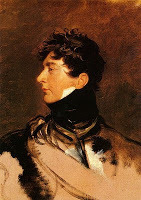 There is often confusion about the date the Regency begins, February 5 or February 6. Royal Assent to the Regency Act was given on February 5 1811. George, Prince of Wales was sworn in as Regent on February 6. He was in his forty-ninth year. He had been excluded from any form of meaningful participation in Government by his father until that date.
There is often confusion about the date the Regency begins, February 5 or February 6. Royal Assent to the Regency Act was given on February 5 1811. George, Prince of Wales was sworn in as Regent on February 6. He was in his forty-ninth year. He had been excluded from any form of meaningful participation in Government by his father until that date.
At Carlton House on February 6, the band of the Grenadiers in white gaiters played in the courtyard, while Privy Councillors and Peers entered the house for the swearing in.
To everyone's surprise, and the Whigs chagrin, he decided to keep his father's Tory Ministers. He kept those ministers waiting for two hours. Out of the windows they no doubt saw the Prince's daughter, Princess Charlot,te on horseback riding about the garden with two grooms. One can imagine how interested she must have been in the proceedings.
The Prince did not celebrate this great event until later that summer in June.
The Regency period, and the years that surround it mark a time of change. Real change from the earlier Georgian period with their powdered hair and wigs, to a period much more recognizable in our modern time. Many of the designs of that era are well thought of today. Medicine and mechanical transportation were in their infancy and knowledge increased exponentially. During the 200th Anniversary I hope to address events and of note during this period.
Today is the first day of the 200th Anniversary. Do you have any special plans? I will be reading all I can find on those very specific years, so I can share it with you.
Until Next time, Happy Rambles
 There is often confusion about the date the Regency begins, February 5 or February 6. Royal Assent to the Regency Act was given on February 5 1811. George, Prince of Wales was sworn in as Regent on February 6. He was in his forty-ninth year. He had been excluded from any form of meaningful participation in Government by his father until that date.
There is often confusion about the date the Regency begins, February 5 or February 6. Royal Assent to the Regency Act was given on February 5 1811. George, Prince of Wales was sworn in as Regent on February 6. He was in his forty-ninth year. He had been excluded from any form of meaningful participation in Government by his father until that date.At Carlton House on February 6, the band of the Grenadiers in white gaiters played in the courtyard, while Privy Councillors and Peers entered the house for the swearing in.
To everyone's surprise, and the Whigs chagrin, he decided to keep his father's Tory Ministers. He kept those ministers waiting for two hours. Out of the windows they no doubt saw the Prince's daughter, Princess Charlot,te on horseback riding about the garden with two grooms. One can imagine how interested she must have been in the proceedings.
The Prince did not celebrate this great event until later that summer in June.
The Regency period, and the years that surround it mark a time of change. Real change from the earlier Georgian period with their powdered hair and wigs, to a period much more recognizable in our modern time. Many of the designs of that era are well thought of today. Medicine and mechanical transportation were in their infancy and knowledge increased exponentially. During the 200th Anniversary I hope to address events and of note during this period.
Today is the first day of the 200th Anniversary. Do you have any special plans? I will be reading all I can find on those very specific years, so I can share it with you.
Until Next time, Happy Rambles
Published on February 05, 2011 22:00
February 2, 2011
Regency Fashion for January
A bit late I know but I wanted to get this in before we started on our new Fashion format tied to the years of the Regency. Oh and the sneak peek we had yesterday, well the cover is now up on Amazon.
Looking back at previous posts for January, I see that last year's post on fashion showed England as snowbound, this year I would say it is North America that is showing a lot more white than usual.
The long Regency era covers from say the late 1780's to 1830. Since the rest of the posts this year will focus strictly on the years of the British Regency, when Britain had a Regent 1811 to 1820, in celebration of the 200th Anniversary. Today I am going 1807
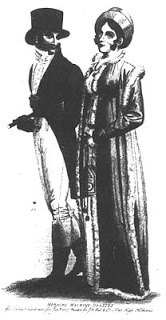 I like this one because it it has a very elegant Gentleman walking with the lady.
I like this one because it it has a very elegant Gentleman walking with the lady.
It comes from Le Beaumonde for January 1807
A plain muslin dress, walking length, made high in front, and forms a shirt collar, richly embroidered; long sleeves, also embroidered round the wrists, and at the bottom of the dress; a pelisse opera coat, without any seam in the back, composed of orange-blossom tinged with brown, made of Angola cloth, or sarsnet, trimmed either with rich Chinchealley [sic] fur, or sable tipt with gold; white fur will also look extremely delicate. The pelisse sets close to the form on one side, and is fastened on the right shoulder with a broach; both sides may be worn close as a wrapping pelisse.
Indispensables are still much worn, and of the same colour as the dress. The Agrippina hat, made at Millard's, corner of Southampton-street, Strand, is truly elegant and quite new; the hair in loose curls, confined with a band of hair: ear-rings are quite out of fashion. Leather gloves, and high shoes or half-boots, or orange-blossom, brown velvet or kid.
Sadly no description for the gentleman. Of more intereste is the actual name and address of the make of the Hat. A nice little detail for a novel.
That's it for me, but I do hope those dealing with snow and others dealing with storms are managing as best they can. Until next time, Happy Rambles
Looking back at previous posts for January, I see that last year's post on fashion showed England as snowbound, this year I would say it is North America that is showing a lot more white than usual.
The long Regency era covers from say the late 1780's to 1830. Since the rest of the posts this year will focus strictly on the years of the British Regency, when Britain had a Regent 1811 to 1820, in celebration of the 200th Anniversary. Today I am going 1807
 I like this one because it it has a very elegant Gentleman walking with the lady.
I like this one because it it has a very elegant Gentleman walking with the lady.It comes from Le Beaumonde for January 1807
A plain muslin dress, walking length, made high in front, and forms a shirt collar, richly embroidered; long sleeves, also embroidered round the wrists, and at the bottom of the dress; a pelisse opera coat, without any seam in the back, composed of orange-blossom tinged with brown, made of Angola cloth, or sarsnet, trimmed either with rich Chinchealley [sic] fur, or sable tipt with gold; white fur will also look extremely delicate. The pelisse sets close to the form on one side, and is fastened on the right shoulder with a broach; both sides may be worn close as a wrapping pelisse.
Indispensables are still much worn, and of the same colour as the dress. The Agrippina hat, made at Millard's, corner of Southampton-street, Strand, is truly elegant and quite new; the hair in loose curls, confined with a band of hair: ear-rings are quite out of fashion. Leather gloves, and high shoes or half-boots, or orange-blossom, brown velvet or kid.
Sadly no description for the gentleman. Of more intereste is the actual name and address of the make of the Hat. A nice little detail for a novel.
That's it for me, but I do hope those dealing with snow and others dealing with storms are managing as best they can. Until next time, Happy Rambles
Published on February 02, 2011 19:23
January 28, 2011
Bragging
New covers are always exciting and scary. I am sure I have said this before. On the left is the North American April Release for, The Gamekeeper's Lady, and on the right the same book issued in the UK in December. Both do justice to my heroine, so I can stop holding my breath. Oh, no! I can't, because there is a book out in May. More than a Mistress is a sequel to The Gamekeeper's Lady. Now I have to start holding my breath all over again.
[image error] [image error] The Gamekeeper's Lady
A most forbidden attraction! Frederica Bracewell grew up under a cloud of shame. As an illegitimate child, she was treated by her uncle like a servant. It isn't until she encounters the new gamekeeper that shy, innocent Frederica starts to feel like a true lady...Lord Robert Mountford has been banished by his family. After a debauched existence, he revels in the simplicity of a gamekeeper's lifestyle. Until temptation strikes! Frederica's plain appearance and stuttering speech are a far cry from the ladies of the ton, but she may just be his undoing...and unmasking!
If you fancy buying a copy use the links in the sidebar to order or pre-order depending on where you live or go to your local bookstore or library and enjoy!
Until next time, Happy Rambles.
[image error] [image error] The Gamekeeper's Lady
A most forbidden attraction! Frederica Bracewell grew up under a cloud of shame. As an illegitimate child, she was treated by her uncle like a servant. It isn't until she encounters the new gamekeeper that shy, innocent Frederica starts to feel like a true lady...Lord Robert Mountford has been banished by his family. After a debauched existence, he revels in the simplicity of a gamekeeper's lifestyle. Until temptation strikes! Frederica's plain appearance and stuttering speech are a far cry from the ladies of the ton, but she may just be his undoing...and unmasking!
If you fancy buying a copy use the links in the sidebar to order or pre-order depending on where you live or go to your local bookstore or library and enjoy!
Until next time, Happy Rambles.
Published on January 28, 2011 05:26



